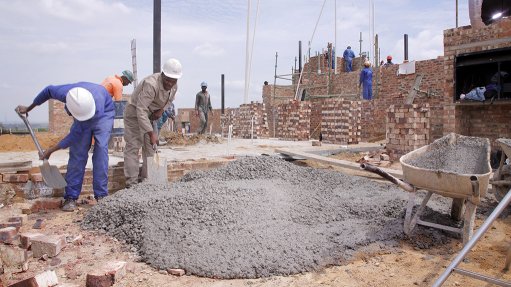New toilet can save 30% of water and 30% of consumers' water bills
South Africa has developed a revolutionary new toilet that uses less than two litres of water for a full flush – saving around 700 litres of water a person every month.
Normal lavatories use between six and 12 litres for each flush and account for 30% to 40% of a household's water use, so the new loo can save on water bills.
Cape Town civil engineer Jonny Harris, who attended the World Toilet Day Dialogue at UCT on Monday, designed the micro-flush toilet. Harris said in an interview at the event that the plastic version of the new loo was already being manufactured in Cape Town and would be available in January.
"But the first six months of production are already pretty committed. We've got a lot of interest from customers waiting to buy."
Natural vortex shape
It is called the Arumloo, after the Arum Lily that has a natural vortex shape.
Harris said the toilet mimicked nature, drawing inspiration from "the function and beauty" of the Arum Lily.
"We've taken that vortex shape for the bowl of the toilet. The vortex shape is found repeatedly in nature and represents the easiest flow path for a fluid. By mimicking this vortex shape, and a circular flush motion, the toilet is able to use less water to clean the bowl and clear waste past the water seal."
One of the attractions of the Arumloo is that it can be used in towns and cities, where it is connected to the urban sewerage system, but can also be used in areas where there is no sewerage system, as it can be connected to a septic tank or on-site treatment system.
Harris said this made it a toilet that could be used in the affluent suburbs and under-serviced informal settlements.
"The idea is to try to bring equity into sanitation," Harris said.
Harris said the next step was to get a ceramic version of the toilet.
In his testing of the efficacy of the system, Harris used "faeces" made out of soya paste.
Six of these samples, each weighing 50 g, plus four "scrunches" of loo paper, can be flushed away with 1.75 litres of water. The Arumloo has a small flush button for liquids only, which uses 0.75 litres a flush. This brings the average water use to less than 1 litre per flush. The loo was developed with funding from the Water Research Commission and other investors.
Sanitation crisis
Dr Sudhir Pillay of the Water Research Commission (WRC), said at the dialogue meeting that the design of the lavatory had not changed for 150 years, but circumstances had. One of them was the increasing scarcity of fresh water.
"With climate change, droughts are becoming more frequent. By 2030, water demand is forecast to outstrip supply in South Africa. So with that in mind, is it right to take clean drinking water into toilets and pollute it with poo and pee?" Pillay said.
The WRC had help fund the Arumloo because of its low water usage. The United Nations (UN) established World Toilet Day to highlight the "sanitation crisis".
Around 60% of the world's population does not have a lavatory at home, while one-third of schools worldwide provide no toilet facilities. The UN says the world is not on track to reach Sustainable Development Goal 6, which is that everyone has a toilet by 2030.
"Today 4.5-billion live without a safe toilet and 892-million people still practice open defecation. The impact of exposure to human faeces on this scale has a devastating impact on public health," the UN website said.
Comments
Press Office
Announcements
What's On
Subscribe to improve your user experience...
Option 1 (equivalent of R125 a month):
Receive a weekly copy of Creamer Media's Engineering News & Mining Weekly magazine
(print copy for those in South Africa and e-magazine for those outside of South Africa)
Receive daily email newsletters
Access to full search results
Access archive of magazine back copies
Access to Projects in Progress
Access to ONE Research Report of your choice in PDF format
Option 2 (equivalent of R375 a month):
All benefits from Option 1
PLUS
Access to Creamer Media's Research Channel Africa for ALL Research Reports, in PDF format, on various industrial and mining sectors
including Electricity; Water; Energy Transition; Hydrogen; Roads, Rail and Ports; Coal; Gold; Platinum; Battery Metals; etc.
Already a subscriber?
Forgotten your password?
Receive weekly copy of Creamer Media's Engineering News & Mining Weekly magazine (print copy for those in South Africa and e-magazine for those outside of South Africa)
➕
Recieve daily email newsletters
➕
Access to full search results
➕
Access archive of magazine back copies
➕
Access to Projects in Progress
➕
Access to ONE Research Report of your choice in PDF format
RESEARCH CHANNEL AFRICA
R4500 (equivalent of R375 a month)
SUBSCRIBEAll benefits from Option 1
➕
Access to Creamer Media's Research Channel Africa for ALL Research Reports on various industrial and mining sectors, in PDF format, including on:
Electricity
➕
Water
➕
Energy Transition
➕
Hydrogen
➕
Roads, Rail and Ports
➕
Coal
➕
Gold
➕
Platinum
➕
Battery Metals
➕
etc.
Receive all benefits from Option 1 or Option 2 delivered to numerous people at your company
➕
Multiple User names and Passwords for simultaneous log-ins
➕
Intranet integration access to all in your organisation

















